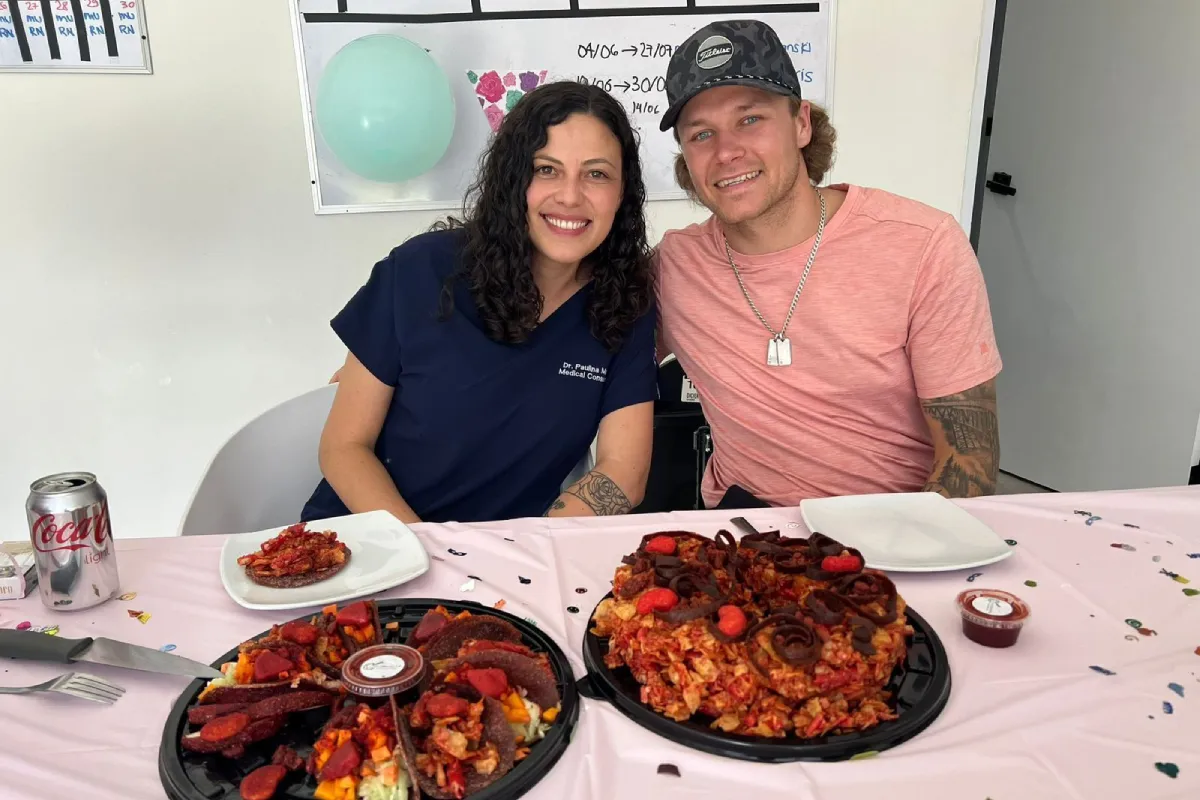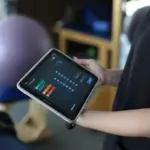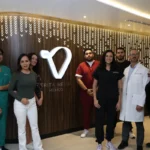In a recent YouTube Live and Facebook Live Q&A session, Attending Physician Dr. Paulina Marin was joined by Brock Leitner, a paraplegic T6 complete spinal cord injury patient from Canada. Brock and Dr. Paulina discussed the Epidural Stimulation and Stem Cell treatment Brock received at our hospital in Guadalajara, Mexico in May 2024, and answered questions from the live audience.
A Conversation with Dr. Paulina and Patient, Brock
“It was an amazing experience, amazing treatment, and it’s definitely changed my life… That was the coolest feeling, being able to stand on my own again, without assistance.” – Brock Leitner, August 2025
Please introduce yourself and tell us about your injury.
Brock: My name is Brock Leitner. I am 27 years old. I’m from Canada and I was down at Vertia Neuro in Mexico last June (2024) where I had Epidural Stimulator and Stem Cell treatments. I was injured on June 12th, 2022. I used to race motocross and supercross professionally and was injured during this. When I arrived at Verita Neuro, I had a T6 Complete Spinal Cord Injury, which we have now deemed Incomplete.
Can you share what your condition was like before the treatment?
Brock: Before the treatment I couldn’t move anything below the level of injury and now after the Epidural Stimulation and Stem Cell treatments I’m able to do a lot of movements with my legs. I can do physical therapy exercises as well, like my lower back program and core program.
There’s a lot I can do now that I couldn’t do before to help maintain muscle and gain muscle. So, it’s been amazing. I haven’t skipped a day since I got the Epidural Stimulator.
Did you receive any treatment before coming to Verita Neuro?
Brock: No, I didn’t do anything. I was doing workouts on my own for workouts with some physiotherapy.
How did you first hear about Epidural Stimulation treatment at Verita Neuro? What made you decide to try it?
Brock: I heard about Verita Neuro through two people who had visited for treatment: One went to Bangkok and one went to Guadalajara. I just thought it was amazing that there’s technology out there that can get you back to a more normal life and get you using the body parts that you’ve lost control of.
As soon as I heard about it, my parents and I talked about it and thought, “If there’s a chance to do something, then let’s do it and give it an honest effort”. I’m super happy that I did. It was an amazing experience, amazing treatment, and it’s definitely changed my life.
What was your expectation before having the treatment?
Brock: I had high hopes of being able to move my legs. That was the biggest one but I really just wanted to see what I could achieve. By the end of it I did a lot more than just moving my legs, and I put in a lot of work to get there. You can’t just expect something to happen overnight; it’s a work in progress.
The Mappers and the Physical Therapists are amazing. They’re very knowledgeable, and they’ll push as hard as you want to push. I reached the point where I can complete solid workout programs. When I was there, I was able to stand while the Stimulator was on, holding on to parallel bars. That was the coolest feeling, being able to stand on my own again, without assistance from someone else. So, that was amazing.
Brock’s Epidural Stimulation Treatment at Verita Neuro in Mexico
Can you tell us about the treatment?
Dr. Paulina: Brock had an Epidural Stimulation surgery. He had a Lumbar Stimulator, and completed a 35 day program. The first day we did all the tests and MRI, some consultations with the cardiologist and a few other staff to make sure everything was okay for the surgery.
After that we performed the surgery on the second day, and the first 10 days were spent at the hospital, so we can take care of the wound and treat it with antibiotics. Then 48 hours after the surgery, we started a process that is called mapping, which we use to program the Stimulator and the electrodes to make the muscles start moving. So now we’re going to talk a little bit more about what happened after the surgery.
Can you walk us through what a typical day looked like during your program here in Mexico?
Brock: Yeah, it was very busy, but it was amazing. When I first got to the hospital in Guadalajara, I got the Epidural Stimulation surgery and then the Stem Cells. I was in the hospital for 10 days, recovering from the surgery. After that there’s a two-hour session in the morning and a 2-hour session in the afternoon of physical therapy and mapping.
You’re definitely tired at the end of each day. You have sessions Monday to Saturday. Saturday is a little bit more of a relaxed day, with only one physical therapy session and then you have Sunday off. I was down there for 35 days. It was amazing. The time flew by.
All of the staff, the Physical Therapists, the Doctors, the Mappers… Everyone was just amazing. The whole facility is very welcoming and it’s your home for 35 days and it’s definitely a nice place to be.
The Results: Brock’s Achievements with Epidural Stimulation
How soon after the surgery did you start to see changes?
Brock: Very soon. As soon as the mapping team came in, we immediately went to work doing leg extensions sitting in my chair. Within the first couple of mapping sessions I was getting a lot of movement in my legs and a lot of contraction in my quads. It was just so cool to see the muscles still working and to start building muscle again.
What were some of the biggest challenges you faced early on?
Brock: One of the big challenges was spasticity. My legs were very spastic all throughout the day. I would get very, very tight and it would be quite uncomfortable, from not being able to move my legs, even though I would stretch.
After the treatment, being able to do leg exercises every day not only makes my body feel a lot better, but it also puts a lot of that built-up spasticity to use. And afterwards, it’s no different than doing a full body workout as an able-bodied person. You know, at the end of it, your body feels a little bit fatigued, but at the same time, you feel good and you feel refreshed.
Doctor’s Note: Spasticity after a spinal cord injury is found in more than 60% of patients. Spinal cord motor neurons become highly sensitive to the residual signals passing through the spinal cord and result in abnormal and consistent muscle contractions.
Were there any moments during your treatment that surprised you? Either physically or emotionally?
Brock: I mean, a lot of it surprised me. Just the way that the technology works surprised me, and how the Stimulator and the electrodes work together. One day everything is working really well and then the next day, you might lose that progress a little bit and teh same muscle is not firing with those electrodes. And, you know, that can be a little bit of a bummer but you know that you can work past it and that the team’s going to figure out what our solution is.
What do you think has been your biggest achievement so far?
Brock: I think the biggest achievement, with my own body, has been the muscles on my legs. I’m now three years post injury and I have muscles on my legs. So it’s a big achievement that the atrophy didn’t just take the muscle away. I can see that the muscles have gotten bigger since doing treatment at Verita Neuro, doing the leg extension workouts and using ankle weights.
One Year Later: Brock’s Pursuit of Adaptive Golfing
Over the past year since your treatment, have you noticed any new improvements, big or small?
Brock: Yeah, I’m glad this is the next question because I was going to say, when I was at Verita Neuro, my left leg was definitely the strongest when it came to leg extensions. Even when standing, my left leg would always lock out and be good and solid. But my right leg struggled to lock out. That was a struggle when I was standing or doing my leg extensions with the Physical Therapists and the Mappers.
Now, after doing the exercises every day for just over a year since treatment, my right leg is very strong. I can get a full lockout, and I have a lot of muscle tone built up around the knee and in my quads. So that was a huge bonus. And that just proves that the more you work, the stronger you’re going to get.
We see you have now taken up adaptive golf. How did that start?
Brock: Yeah, I’m a full-time golfer now. I’ve been a golfer ever since I was 13 years old. I’m 27 now and I got injured when I was 24. It was a little bit tough to golf as much as I wanted to before my injury because I was busy racing motocross and supercross professionally all over North America. Before my injury, I was down as low as a four handicap in the golfing world.
So when I got hurt, I didn’t want to stop playing the game that I loved. I actually started playing golf sitting in my wheelchair cutting my clubs shorter. Then when I got home from Verita Neuro, I was able to sit down and stand up again, so I was able to order a machine called a ParaGolfer. The ParaGolfer gives you the opportunity to play golf standing up. For me, because I don’t have great core control, I only swing with one arm, but it’s absolutely amazing.
I’ve been doing adaptive tournaments all over Canada and the US now. This year I actually qualified and competed in the fourth annual US adaptive open. Right now it’s the biggest adaptive tournament in the world, I believe. All different countries come to play in it and there’s a qualifier for it. So it’s been an amazing journey.
Talking about Adaptive Golf, what does a typical training or competition day look like for you?
Brock: Every morning I wake up, I usually do my leg exercises with the Epidural Stimulator in the mornings, just because it loosens my whole body up. Not just my legs, it helps with my core too. This is important because I’m going to be sitting down and standing up all day in my ParaGolfer.
So, I start with that and then I head to the course and I’m on the range for about 20 to 30 minutes before starting the round. So, the nice thing with the ParaGolfer is that I am able to stand up with parallel bars, after the treatment. The machine is holding me in with a chest strap and there’s a knee strap that’s locking my knees out.
I’m usually standing up and sitting down around 80 times a day when I’m golfing, across the chipping green, the range, the putting green, and the golf round. It’s amazing to be able to stand up that much.
Brock’s Commitment to Physical Therapy and His Message to Others
Since you finished your program last May, have you continued with physical therapy or training at home?
Brock: Yeah, I use my Stimulator every day. I know you’re supposed to take some days off, but I always do my leg extensions every day. And then I take days off with some of the other programs, but I’m using the leg extension program every day. Sometimes I might not do as many sets and as many reps, but I’m still using it to help with that muscle tone. It also helps with my spasticity a lot, making my legs a little bit more calm throughout the day.
Dr. Paulina: I think it’s really important for people to know that if you’re looking to do this treatment, you don’t just do the surgery and automatically see results. You need to work a lot like Brock was telling us. You need to implement your programs to improve your muscle tone, to improve the contractions and to practice the standing movements. So that’s why Brock is talking about doing more physical therapy. He’s using his programs every day, which is great. We recommend at least five days of the week, but every day is good, too, because he will improve more with the programs.
Looking back, what advice would you give to someone considering an Epidural Stimulation treatment?
Brock: Still to this day I have people reach out to me and ask me questions about the treatment, like, “Hey, is it worth it? Did you gain anything?” And I always say it’s 100% worth it. But at the same time, like I said earlier, you’re only going to get out of it what you put into it. So, if you’re not willing to put in the work and you’re not going to be pursuing your exercises after the surgery, then there’s probably no point. But, if you’re going to be dedicated to it, it’s going to change your life.
Brock’s Tips for a Strong Mindset
What kept you motivated through the tough days, both during treatment and after you went home?
Brock: Every day is a new day. Everyone has their struggles. It doesn’t matter if you’ve had a life-changing injury or not. Everyone has those days where they’re not feeling great about things. You’ve just got to think of the bright side and think what you have going for you and all the amazing things in life. I always think about how much better it’s going to be the next day.
When I was at treatment, there were a couple of days where programs that were working well the day before would stop working so well. Sometimes it felt like you’d take one step forward and two steps back. But you just have to believe in the process and have a strong mind. The Mappers and the Physical Therapists and the Doctors are going to do everything they can to get you back on track and to keep you improving. And you know what? At the end of the day, they did. Every step back that we took, we gained again.
How has your mindset changed from the early days of your injury to where you are now?
Brock: For me personally, even before my injury, I was very positive. I’ve always been a go-getter. Then after my injury, I remained very positive. But now after the treatment at Verita Neuro, I feel like I’m doing something that’s really healthy for my body and I’m bettering myself. So, I’m not whittling away, I’m rebuilding, if you will.
What message would you like to give to people who are in the early stage of the injury?
Brock: I think for anyone that has a life-changing injury, or has a family member that’s got a life-changing injury… The most important thing is to try your best to keep a positive mindset. Be supportive and accept support on down days, because those days are going to come. Trust that everything is going to work out.
The above is not a verbatim transcript of Brock’s live interview. Some comments have been altered or rearranged to improve the reading flow. You can watch the full live on our YouTube channel.





